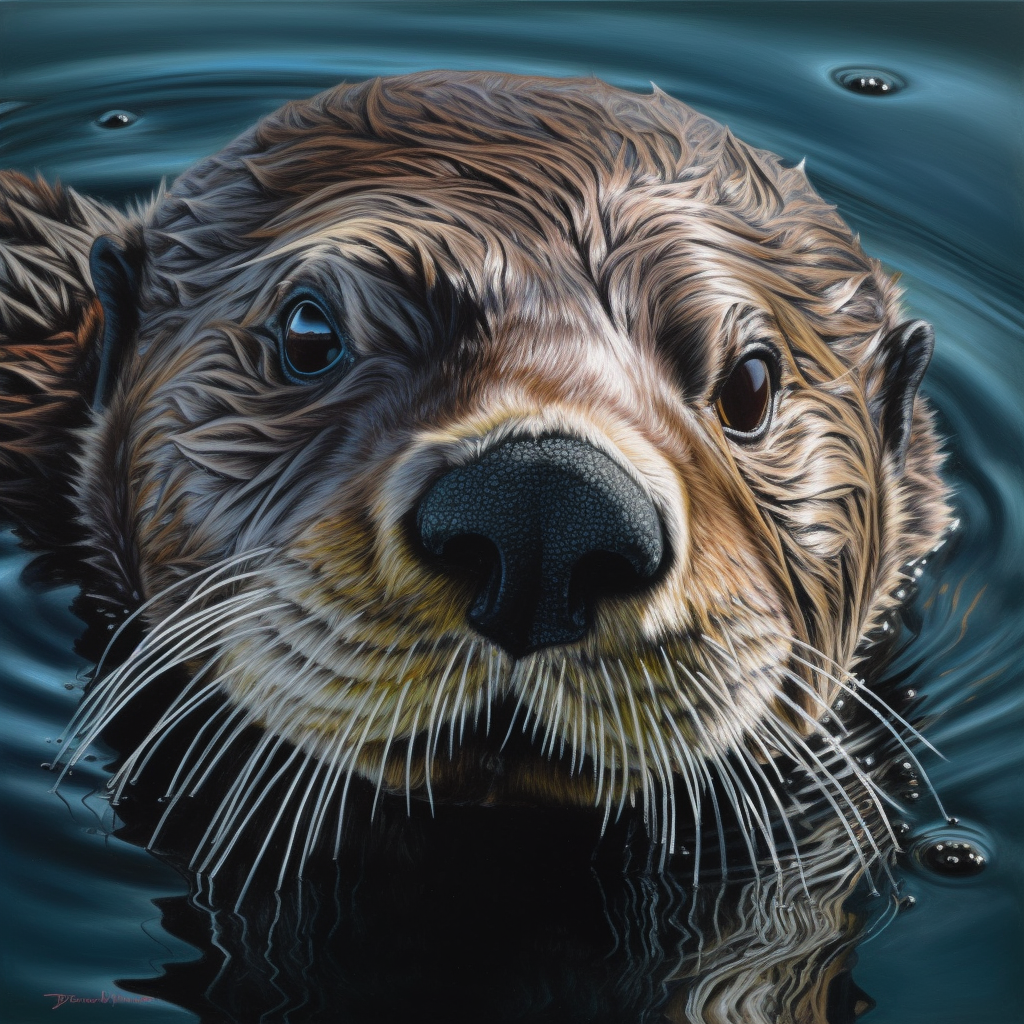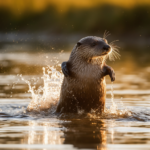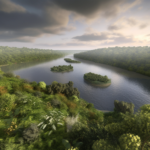Sea otters are fascinating marine mammals known for their playful behavior and adorable appearance. They inhabit coastal waters of the northern Pacific Ocean and are often found in kelp forests, where they play a crucial role in maintaining the balance of the ecosystem. One of the questions that often comes to mind is whether sea otters eat starfish. In this article, we will explore the dietary habits of sea otters and delve into the intriguing relationship between these charismatic creatures and the starfish they encounter in their habitat. So, let’s dive in and discover the truth about whether sea otters feast on starfish or not.
Key Takeaways
- Sea otters are known to eat starfish as part of their diet.
- Starfish are a common prey item for sea otters, especially in areas where they are abundant.
- Sea otters play an important role in maintaining the balance of marine ecosystems by controlling the population of starfish and other prey species.
- The decline in sea otter populations can have negative impacts on the abundance of starfish and the overall health of marine ecosystems.
The Diet of Sea Otters: An Overview
Sea otters are fascinating creatures that inhabit coastal waters and play a vital role in maintaining the balance of marine ecosystems. Their diet consists of a variety of marine life, making them an important link in the underwater food chain. In this section, we will explore what sea otters eat in the ocean, their relationship with starfish and sea stars, and their consumption of sunflower stars.
A. What Do Otters Eat in the Ocean?
Sea otters have a diverse diet that includes a wide range of marine organisms. They are known to be opportunistic feeders, meaning they will consume whatever is readily available in their habitat. Some of the main food sources for sea otters include:
-
Shellfish: Sea otters have a remarkable ability to crack open shells using rocks or other hard objects. They feed on a variety of shellfish, including clams, mussels, and crabs. Their strong jaws and sharp teeth allow them to extract the meat from the shells with ease.
-
Sea Urchins: Sea otters are particularly fond of sea urchins, which are spiky creatures that inhabit rocky areas. These otters play a crucial role in controlling the population of sea urchins, as excessive numbers can lead to the destruction of kelp forests. By feeding on sea urchins, sea otters help maintain the health and balance of the marine ecosystem.
-
Fish: While not their primary food source, sea otters do consume fish when available. They are skilled hunters and can catch fish using their dexterous paws and strong swimming abilities. Common fish species consumed by sea otters include salmon, herring, and rockfish.
-
Other Invertebrates: Sea otters also feed on a variety of other invertebrates, such as octopuses, squid, and snails. These creatures provide a nutritious meal for the otters and contribute to their overall diet.
B. Do Otters Eat Starfish and Sea Stars?
Yes, sea otters do eat starfish and sea stars. These marine creatures are part of their diet, although the extent of their consumption may vary depending on the otter‘s location and the availability of other food sources. Sea otters are considered one of the main predators of starfish in their habitat.
When hunting for starfish, sea otters employ their excellent diving and swimming skills. They search the ocean floor, using their sensitive whiskers to locate their prey. Once a starfish is found, the otter will grasp it with its paws and bring it to the surface. They typically consume the soft tissues of the starfish, leaving behind the harder parts.
C. Do Sea Otters Eat Sunflower Stars?
Sunflower stars, also known as sunflower sea stars, are a specific species of starfish that can grow to impressive sizes. These starfish have numerous arms and are known for their vibrant colors. While sea otters do consume starfish, they are less likely to prey on sunflower stars due to their size and defense mechanisms.
Sunflower stars have a unique ability to regenerate their arms, making them less vulnerable to predation. Additionally, their large size and spiny exterior act as deterrents to potential predators. While sea otters may occasionally consume sunflower stars, they are more likely to target smaller and more accessible starfish species.
In conclusion, sea otters have a diverse diet that includes shellfish, sea urchins, fish, and other invertebrates. They are known to consume starfish, although their consumption of sunflower stars is less common. By feeding on various marine organisms, sea otters play a crucial role in maintaining the balance of the marine ecosystem.
The Eating Habits of Sea Otters

Sea otters are fascinating creatures that play a crucial role in the marine ecosystem. Their diet consists of a variety of marine life, including starfish. In this section, we will explore where sea otters eat, how often they eat, and how much they consume.
A. Where Do Sea Otters Eat?
Sea otters can be found along the coastlines of the northern Pacific Ocean, from Alaska to California. They inhabit both nearshore and offshore environments, including kelp forests, rocky shores, estuaries, and open water. These diverse habitats provide sea otters with ample opportunities to find food.
When it comes to feeding, sea otters are highly adaptable. They are known for their ability to forage in shallow waters as well as dive to great depths. Sea otters are excellent swimmers and can spend a significant amount of time underwater in search of food. They use their dexterous front paws to locate and capture their prey.
B. How Often Do Sea Otters Eat?
Sea otters have a high metabolic rate, which means they need to eat frequently to sustain their energy levels. On average, sea otters consume about 20-30% of their body weight in food each day. This translates to approximately 4-6 kilograms (8-13 pounds) of food for an adult sea otter.
Sea otters typically feed throughout the day, with no specific feeding schedule. They are opportunistic feeders, taking advantage of whatever food sources are available in their habitat. This can include a wide range of marine invertebrates, such as crabs, clams, snails, and of course, starfish.
C. How Much Do Sea Otters Eat?
The amount of food sea otters consume depends on various factors, including their size, age, and activity level. Adult sea otters generally eat more than juveniles or pups. They have a higher energy requirement due to their larger size and greater muscle mass.
Sea otters have a diverse diet, and the quantity of food they consume can vary based on the availability of prey. For example, if there is an abundance of starfish in their habitat, sea otters may consume a larger quantity of starfish. However, they also consume other prey items to maintain a balanced diet.
In conclusion, sea otters are voracious eaters that play a vital role in maintaining the balance of the marine ecosystem. Their ability to adapt to different habitats and their frequent feeding habits ensure they have access to a variety of food sources, including starfish. By regulating the populations of starfish and other prey species, sea otters contribute to the overall health and stability of the oceanic food web.
The Unique Eating Techniques of Sea Otters

Sea otters are fascinating creatures known for their playful behavior and their important role in maintaining the balance of the marine ecosystem. One of the most intriguing aspects of sea otters is their eating habits. In this section, we will explore how sea otters eat and why they consume such large quantities of food.
A. How Do Sea Otters Eat?
Sea otters have developed unique techniques for obtaining and consuming their food. They are primarily carnivorous and feed on a variety of marine life, including fish, crabs, clams, and yes, even starfish.
When it comes to hunting for starfish, sea otters display remarkable dexterity and agility. They are known to dive underwater and search for their prey using their sensitive whiskers. Once they locate a starfish, they use their forepaws to grasp it firmly. Sea otters have a loose patch of skin under each forelimb, which they can use as a pouch to store their catch. This allows them to bring their prey to the surface for consumption.
To eat a starfish, sea otters employ a unique feeding behavior. They position themselves on their backs in the water, holding the starfish against their chest. Using their forepaws, they skillfully manipulate the starfish, turning it over to expose the soft underside. Sea otters then use their strong teeth to tear apart the starfish, starting with the arms and working their way towards the central disk. This feeding technique allows them to access the nutritious parts of the starfish while discarding the harder, less edible portions.
B. Why Do Sea Otters Eat So Much?
Sea otters have a high metabolic rate, which means they require a substantial amount of food to sustain their energy levels. They spend a significant portion of their day foraging for food, often consuming up to 25% of their body weight in a single day. This voracious appetite is necessary for their survival and overall well-being.
The abundance of food in their diet is crucial for sea otters to maintain their body temperature. Unlike other marine mammals, sea otters lack a layer of blubber to keep them warm in the cold ocean waters. Instead, they rely on their dense fur, which traps air and provides insulation. However, this insulation is only effective if the sea otter’s fur remains clean and free of oil. To keep their fur clean, sea otters spend a significant amount of time grooming themselves, which requires a substantial amount of energy. By consuming a large quantity of food, sea otters can replenish the energy they expend during grooming and maintain their body temperature.
Additionally, sea otters play a vital role in the marine ecosystem by controlling the population of certain prey species, such as starfish. Starfish are known to feed on kelp, which is an essential component of the underwater ecosystem. By consuming starfish, sea otters help prevent overgrazing of kelp forests, allowing other marine life to thrive.
In conclusion, sea otters have unique eating techniques that enable them to consume a variety of marine life, including starfish. Their ability to manipulate their prey and their high food intake are essential for their survival and their role in maintaining the balance of the marine ecosystem. So, the next time you spot a sea otter floating on its back, remember that it’s not just enjoying a leisurely meal, but actively contributing to the health of our oceans.
The Role of Sea Urchins in Sea Otters’ Diet

Sea otters are fascinating creatures that play a crucial role in maintaining the balance of the marine ecosystem. While they are known for their love of shellfish, such as clams and mussels, they also have a taste for sea urchins. In this section, we will explore the relationship between sea otters and sea urchins, answering the questions “Do sea otters eat sea urchins?” and “Why do sea otters eat sea urchins?”
A. Do Sea Otters Eat Sea Urchins?
Sea otters are indeed known to eat sea urchins. These spiky creatures are a part of the sea otters’ diverse diet, which also includes other invertebrates like crabs, snails, and abalone. Sea otters have a remarkable ability to dive and forage underwater, using their dexterous paws to search for food. When it comes to sea urchins, they are a popular choice for sea otters, especially along the Pacific coast.
B. Why Do Sea Otters Eat Sea Urchins?
Sea otters play a crucial role in controlling the population of sea urchins, and this has a significant impact on the health of the underwater ecosystem. Sea urchins are herbivores that feed on kelp, a type of seaweed. When sea otters consume sea urchins, they help prevent overgrazing of kelp forests by keeping the sea urchin population in check.
Kelp forests are essential habitats for a wide range of marine organisms, providing shelter and food. When sea urchins multiply unchecked, they can decimate kelp forests, leading to a loss of biodiversity and disrupting the delicate balance of the marine ecosystem. Sea otters act as keystone species, exerting top-down control on the sea urchin population and indirectly protecting the kelp forests.
Sea otters have a unique hunting strategy when it comes to sea urchins. They use their strong teeth to crack open the spiky shells, exposing the soft flesh inside. This behavior requires skill and precision, as sea urchins have a defense mechanism in the form of long, sharp spines. However, sea otters have adapted to deal with this challenge, using rocks or other hard surfaces to break open the shells.
In conclusion, sea otters do eat sea urchins, and this behavior is vital for maintaining the health of the marine ecosystem. By controlling the sea urchin population, sea otters help protect kelp forests and ensure the survival of numerous other species that depend on these habitats. The intricate relationship between sea otters and sea urchins highlights the interconnectedness of marine life and the delicate balance that exists within our oceans.
Conclusion
In conclusion, sea otters are indeed known to eat starfish as part of their diet. These adorable marine mammals have a voracious appetite for various invertebrates, including starfish, which they consume by cracking open the hard shells with their strong teeth. Sea otters play a crucial role in maintaining the balance of marine ecosystems by controlling the population of starfish, preventing them from overgrazing on kelp forests and other important habitats. However, it is important to note that while sea otters primarily feed on starfish, they also consume a wide range of other prey, such as crabs, clams, mussels, and sea urchins. Their diverse diet reflects their adaptability and the vital role they play in the marine food web. Sea otters are fascinating creatures that continue to captivate researchers and conservationists alike, and their relationship with starfish is just one aspect of their fascinating behavior and ecological significance.
Frequently Asked Questions
Where do sea otters eat?
Sea otters typically eat in the water. They are known to float on their backs and use their chests as tables to enjoy their meals.
Do sea otters eat sunflower stars?
Yes, sea otters do eat sunflower stars. This is part of the marine life that forms their diet, contributing to the aquatic food chain.
How do sea otters eat?
Sea otters use their front paws to handle food. They also use rocks as tools to crack open hard-shelled prey like clams and sea urchins.
How often do sea otters eat?
Sea otters eat frequently throughout the day, typically every few hours. This is due to their high metabolism that requires constant nourishment for survival.
Do sea otters eat starfish?
Yes, sea otters do eat starfish. Starfish are part of the otter‘s prey in the marine ecosystem.
Do sea otters eat sea stars?
Yes, sea otters do eat sea stars, which are essentially starfish. This is part of their underwater feeding habits.
What do otters eat in the ocean?
Otters, including sea otters, eat a variety of marine life in the ocean. Their diet includes sea urchins, crabs, clams, snails, starfish, and sometimes fish.
Do otters eat sea stars?
Yes, otters do eat sea stars. This is part of the otter and starfish interaction in the marine ecosystem.
How much do sea otters eat?
Sea otters eat a lot relative to their body weight. They typically consume 25-30% of their body weight in food each day.
Why do sea otters eat so much?
Sea otters eat so much due to their high metabolic rate. They need to consume a large amount of food to generate enough energy to maintain their body temperature in the cold oceanic environment.




